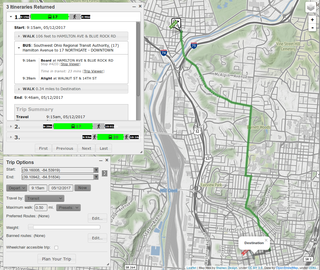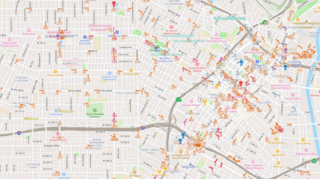ZIP is an archive file format that supports lossless data compression. A ZIP file may contain one or more files or directories that may have been compressed. The ZIP file format permits a number of compression algorithms, though DEFLATE is the most common. This format was originally created in 1989 and was first implemented in PKWARE, Inc.'s PKZIP utility, as a replacement for the previous ARC compression format by Thom Henderson. The ZIP format was then quickly supported by many software utilities other than PKZIP. Microsoft has included built-in ZIP support in versions of Microsoft Windows since 1998 via the "Plus! 98" addon for Windows 98. Native support was added as of the year 2000 in Windows ME. Apple has included built-in ZIP support in Mac OS X 10.3 and later. Most free operating systems have built in support for ZIP in similar manners to Windows and macOS.

In computing, extract, transform, load (ETL) is a three-phase process where data is extracted from an input source, transformed, and loaded into an output data container. The data can be collated from one or more sources and it can also be output to one or more destinations. ETL processing is typically executed using software applications but it can also be done manually by system operators. ETL software typically automates the entire process and can be run manually or on reccurring schedules either as single jobs or aggregated into a batch of jobs.

A bus stop is a place where buses stop for passengers to get on and off the bus. The construction of bus stops tends to reflect the level of usage, where stops at busy locations may have shelters, seating, and possibly electronic passenger information systems; less busy stops may use a simple pole and flag to mark the location. Bus stops are, in some locations, clustered together into transport hubs allowing interchange between routes from nearby stops and with other public transport modes to maximise convenience.

The New York City Transit Authority is a public-benefit corporation in the U.S. state of New York that operates public transportation in New York City. Part of the Metropolitan Transportation Authority, the busiest and largest transit system in North America, the NYCTA has a daily ridership of 8 million trips.

Calligra Sheets is a free software spreadsheet application that is part of Calligra Suite, an integrated graphic art and office suite developed by KDE.

Comma-separated values (CSV) is a text file format that uses commas to separate values, and newlines to separate records. A CSV file stores tabular data in plain text, where each line of the file typically represents one data record. Each record consists of the same number of fields, and these are separated by commas in the CSV file. If the field delimiter itself may appear within a field, fields can be surrounded with quotation marks.
A timing point, time point or timepoint is a public transit stop that a vehicle tries to reach at a scheduled time. A vehicle is not supposed to pass a timepoint until the schedule time has arrived. These stops are contrasted with all other stops on a scheduled route, for which the transit agency does not explicitly schedule an arrival/departure time. These other stops occur between timepoint stops, so their scheduled times are implicitly between those of the timepoints though not explicitly defined. At minimum, it allows regular passengers to estimate when a bus would get to a stop before or after a timepoint.
In computer hypertext, a URI fragment is a string of characters that refers to a resource that is subordinate to another, primary resource. The primary resource is identified by a Uniform Resource Identifier (URI), and the fragment identifier points to the subordinate resource.

A point of interest (POI) is a specific point location that someone may find useful or interesting. An example is a point on the Earth representing the location of the Eiffel Tower, or a point on Mars representing the location of its highest mountain, Olympus Mons. Most consumers use the term when referring to hotels, campsites, fuel stations or any other categories used in modern automotive navigation systems.

The Transport Direct Programme was a division of the UK Department for Transport (DfT) to develop standards, data and better information technology systems to support public transport. It developed and operates the Transport Direct Portal which is a public facing multi-modal journey planner. It also supports the creation and management of comprehensive databases of all public transport movements in the United Kingdom with Traveline. During 2010 two key datasets were released as Open Data and published on www.data.gov.uk.
The Southwest Ohio Regional Transit Authority (SORTA) is the public transport agency serving Cincinnati and its Ohio suburbs. SORTA operates Metro fixed-route buses, bus rapid transit, microtransit, and paratransit services. SORTA's headquarters are located at the Huntington Building in Cincinnati’s Central Business District. The agency is managed by CEO and General Manager Darryl Haley along with a 13-member board of trustees. In 2023, the system had a ridership of 13,091,500, or about 44,800 per weekday as of the fourth quarter of 2023.

GoRaleigh is the transit system responsible for operating most of the public transportation services in Raleigh, North Carolina. The system operates 27 fixed routes throughout the city's municipal area and also operates five regional/express routes in partnership with GoTriangle, the regional provider. GoRaleigh is contracted to operate two additional routes, an express route to the Wake Tech Community College campus south of Raleigh and a local circulator service in the Town of Wake Forest. Capital Area Transit, also known as CAT, was rebranded to GoRaleigh in 2015 under the consolidated GoTransit, a joint branding of municipal and regional transit systems for the Research Triangle. In 2023, the system had a ridership of 5,094,000, or about 14,900 per weekday as of the fourth quarter of 2023.

A passenger information system, or passenger information display system, is an automated system for supplying users of public transport with information about the nature and the state of a public transport service through visual, voice or other media. It is also known as a customer information system or an operational information system. Among the information provided by such systems, a distinction can be drawn between:

A public transport timetable is a document setting out information on public transport service times. Both public timetables to assist passengers with planning a trip and internal timetables to inform employees exist. Typically, the timetable will list the times when a service is scheduled to arrive at and depart from specified locations. It may show all movements at a particular location or all movements on a particular route or for a particular stop. Traditionally this information was provided in printed form, for example as a leaflet or poster. It is now also often available in a variety of electronic formats.
TransXChange is a UK national XML based data standard for the interchange of bus route and timetable information between bus operators, the Vehicle and Operator Services Agency, local authorities and passenger transport executives, and others involved in the provision of passenger information.
The Standard Interface for Real-time Information or SIRI is an XML protocol to allow distributed computers to exchange real-time information about public transport services and vehicles.

A journey planner, trip planner, or route planner is a specialized search engine used to find an optimal means of travelling between two or more given locations, sometimes using more than one transport mode. Searches may be optimized on different criteria, for example fastest, shortest, fewest changes, cheapest. They may be constrained, for example, to leave or arrive at a certain time, to avoid certain waypoints, etc. A single journey may use a sequence of several modes of transport, meaning the system may know about public transport services as well as transport networks for private transportation. Trip planning or journey planning is sometimes distinguished from route planning, which is typically thought of as using private modes of transportation such as cycling, driving, or walking, normally using a single mode at a time. Trip or journey planning, in contrast, would make use of at least one public transport mode which operates according to published schedules; given that public transport services only depart at specific times, an algorithm must therefore not only find a path to a destination, but seek to optimize it so as to minimize the waiting time incurred for each leg. In European Standards such as Transmodel, trip planning is used specifically to describe the planning of a route for a passenger, to avoid confusion with the completely separate process of planning the operational journeys to be made by public transport vehicles on which such trips are made.

Google Fusion Tables was a web service provided by Google for data management. Fusion tables was used for gathering, visualising and sharing data tables. Data are stored in multiple tables that Internet users can view and download.

An isochrone map in geography and urban planning is a map that depicts the area accessible from a point within a certain time threshold. An isochrone is defined as "a line drawn on a map connecting points at which something occurs or arrives at the same time". In hydrology and transportation planning isochrone maps are commonly used to depict areas of equal travel time. The term is also used in cardiology as a tool to visually detect abnormalities using body surface distribution.

GTFS Realtime is an extension to GTFS, in which public transport agencies share real-time vehicle locations, arrival time predictions, and alerts such as detours and cancellations via Protocol Buffers web server.

















